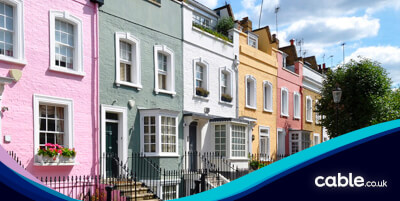What broadband speed can I get in my area?
 Dan Howdle • December 13th, 2024
Dan Howdle • December 13th, 2024

In this guide, we’ll take a detailed look at how to find and access the fastest available internet speed in your area, help you decide which broadband speed your household needs and discuss alternatives to broadband if you live in an area that isn’t well-serviced.
How to check your broadband speed
If you’re not sure what internet speed you’re currently getting, log on to your home network and use our quick broadband speed test to find out. This takes a couple of seconds, and will help you compare broadband speeds to see if a better deal is available in your area.
Use the results to compare what you should be getting against what you could be getting with another supplier. To get estimated speeds in your area, click on the button below.
The best average broadband speed available where you live depends on a couple of factors:
The distance between your home and the nearest cabinet
This matters for ADSL or basic fibre broadband, but won't matter if you're getting Full Fibre or Virgin Media. The green cabinets found on street corners in built-up areas are often referred to as ‘cabinets’ and connect either copper phone lines (for standard / ADSL broadband provision) or fibre optic cables (for fibre broadband provision) to your home.
If you’re signed up to a standard broadband deal, a large distance between your home and the nearest cabinet means slower internet speeds. This explains why homes in remote or rural areas often suffer with slow broadband speed or inconsistent internet connections, as the copper wire transmitting the signal has to travel a long way.
Which networks are available in your area
Almost every home in the UK can get broadband from providers that use the Openreach network, including all the big names, apart from Virgin Media. This means typical speeds of around 70Mbps for fibre broadband, unless your home is located a long way from the nearest cabinet (see above).
Full Fibre is now available to 62% of UK homes, and for Full Fibre it doesn't matter how far you are from the cabinet, so long as you can get it. With cables travelling directly to your property, rather than via the cabinet, you’ll be able to access much faster speeds, up to 944Mbps. At the moment, only a relatively small number of areas in the UK can get this.
Virgin Media runs its own network, which is available to around 60% of UK households. With by far the fastest internet speeds in the country on offer – up to 1130Mbps in fact – Virgin should be your first choice if you want ultrafast broadband and it’s available in your area.
What speed do I need?
If you’re trying to get a general idea of the internet speed that will meet your household’s needs, a good rule of thumb is to use ‘the ten megabit rule’. This means counting 20Mbps of bandwidth for every person you live with that uses the internet.
This rule works pretty well if you live in a small to medium-sized household where people do simple things like browse the web, shop online, use social media and stream content like TV, film and video in 4K.
If anyone in your household is an avid online gamer or downloads large files on a regular basis, you’ll need to add some extra bandwidth to cover these activities. Double it if you can.
If you have a 4K TV and stream 4K content, the bandwidth required for this alone can be anything up to 40Mbps for high frame rate live sports broadcasts (though is generally 20-25Mbps). Bear this in mind when choosing your speed.
Most people are more concerned with download speeds than upload speeds, as the majority of us move more data from the internet to our devices rather than sending it from our devices to the internet. If you store a lot of files online, perhaps because you work from home, or if you regularly upload large files such as videos to social media, for example, it’s worth paying some attention to the upload speeds on offer when choosing a broadband deal.
If you need more help with choosing the right download speed for your needs, our comprehensive guide will help.
Why is the internet slow where I live?
If you’re looking for a solution to a sluggish internet connection, there are several factors to consider:
Do you have ADSL or fibre and live a long way from the nearest cabinet?
We’ve already talked about how the distance between your home and the nearest cabinet can affect your internet speed (the further away you are, the slower your connection will be – even if you are on a fibre connection).
If you think this issue is affecting your broadband speed, consider switching to Virgin Media if it’s available in your local area. Virgin uses its own network, rather than the Openreach network used by all other UK broadband companies, and its provision won’t be affected by cabinet location. Same goes for Full Fibre – if you can get it, this is not something you will ever need to worry about.
Your router is not set up correctly
If your internet connection is weaker or non-existent in some parts of your home than others, your router may be incorrectly installed. Get in touch with your broadband provider to check this out. They may also be able to supply you with a wifi extender to help the signal reach all parts of your home. You might need to pay a small fee for this, but your connection should improve significantly.
For further support with this issue, check out our guide to quickly and correctly setting up your home wifi.
There is a fault
If you were previously receiving the broadband speed you signed up for, but your connection has suddenly become slower or stopped working, there is probably a fault with your internet connection.
Get in touch with your provider as soon as possible to inform them of the problem. It’s likely that they’ll be able to run a quick check to determine if there’s a known fault in your area, and can advise you when it’s due to be fixed.
If the fault isn’t known about or obvious, your provider may need to send out an engineer to diagnose and rectify the problem.
You need a faster package
If your broadband connection regularly slows down to a crawl, or video streams are buffering regularly (pausing with a little spinning circle in the middle), it may be time to find a faster package, provided one is available in your area.
There may be nothing physically wrong with your internet connection. The issue could simply be that your needs have evolved over time, and you require a faster speed to do the things you want to do online.
Talk to your provider about whether an upgrade might be possible, and remember, if you’re part-way through your contract, you’ll probably be charged an early-exit fee if you want to cancel it and switch to a new provider to get a better speed.
Alternatives to fixed-line broadband
If you’re on the fastest broadband connection available in your area and still finding it too slow for your needs, it may be time to start looking at other technologies.
There are three main alternatives to fixed-line broadband:
4G or 5G mobile broadband - If you can’t get a decent enough speed via a fixed line, but you can get a good 4G or 5G mobile signal, many providers now offer home routers that operate via a mobile network. 4G broadband offers good speeds comparable to entry-level fibre if you can get a clear signal. 5G broadband can offer speeds that far exceed it
Satellite broadband – While it’s available to everyone, satellite broadband is expensive, carries data caps and suffers extreme latency. It’s therefore best avoided, unless you live in a location where no other internet connection is possible.
Fixed wireless broadband – This is where a small town or village has a line-of-sight wireless network installed. Vodafone has a few sites like this around the UK, where it uses the highest point in the village – usually a church spire – to mount a transmitter, which beams broadband to homes within sight. Locations where this sort of technology exists are extremely rare however.
